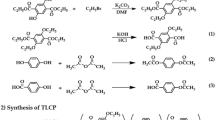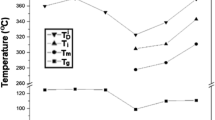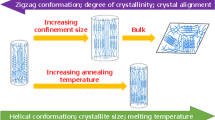Abstract
Liquid crystal polymer (LCP) nanofibers were prepared by electrospinning from isotropic and biphasic poly(γ-benzyl-L-glutamate) (PBLG)/dichloromethane–pyridine solutions. The prepared fibers were characterized by scanning electron microscopy, Fourier-transform infrared spectroscopy, polarized optical microscopy, wide-angle X-ray diffraction and polarized micro-Raman spectroscopy. The as-spun PBLG fiber from the isotropic solutions had an undulating orientation of closed-packed α-helices similar to a serpentine trajectory in their internal structures. The as-spun PBLG fibers from the biphasic solutions that contained the LC phase had uniaxially oriented hexagonal lattices of α-helices along the fiber axis. These results indicated that the orientation of the ordered structure of the electrospun lyotropic LCP fibers can be controlled by the initial microstructure of the spinning solution.
Similar content being viewed by others
Log in or create a free account to read this content
Gain free access to this article, as well as selected content from this journal and more on nature.com
or
References
Doshi, J. & Reneker, D. H. Electrospinning process and applications of electrospun fibers. J. Electrostatics 35, 151–160 (1995).
Reneker, D. H. & Chun, I. Nanometre diameter fibres of polymer, produced by electrospinning. Nanotechnology 7, 216–223 (1996).
Li, D. & Xia, Y. Electrospinning of nanofibers: reinventing the wheel? Adv. Mater. 16, 1151–1170 (2004).
Greiner, A. & Wendorff, J. H. Electrospinning: a fascinating method for the preparation of ultrathin fibers. Angew. Chem. Int. Ed. 46, 5670–5703 (2007).
Kakade, M. V., Givens, S., Gardner, K., Lee, K. H., Chase, D. B. & Rabolt, J. F. Electric field induced orientation of polymer chains in macroscopically aligned electrospun polymer nanofibers. J. Am. Chem. Soc. 129, 2777–2782 (2007).
Kongkhlang, T., Tashiro, K., Kotaki, M. & Chirachanchai, S. Electrospinning as a new technique to control the crystal morphology and molecular orientation of polyoxymethylene nanofibers. J. Am. Chem. Soc. 130, 15460–15466 (2008).
Danno, T., Matsumoto, H., Nasir, M., Shimizu, S., Minagawa, M., Kawaguchi, J., Horibe, H. & Tanioka, A. Fine structure of PVDF nanofiber fabricated by electrospray deposition. J. Polym. Sci. B: Polym. Phys. 46, 58–563 (2008).
Nakashima, K., Tsuboi, K., Matsumoto, H., Ishige, R., Tokita, M., Watanabe, J. & Tanioka, A. Control over internal structure of liquid crystal polymer nanofibers by electrospinning. Macromol. Rapid Commun. 31, 1641–1645 (2010).
Pauling, L. & Corey, R. B. Two hydrogen-bonded spiral configurations of the polypeptide chain. J. Am. Chem. Soc 72, 5349 (1950).
Robinson, C. Liquid-crystalline structures in solutions of a polypeptide. Trans. Faraday Soc., 52, 571–592 (1956).
Robinson, C. Liquid-crystalline structures in solutions of a polypeptide. Part 2. Trans. Faraday Soc. 25, 29–42 (1958).
Flory, P. J. Phase changes in proteins and polypeptides. J. Polymer Sci. 49, 105–128 (1961).
Livolant, F. & Bouligan, Y. Liquid crystalline phases given by helical biological polymers (DNA, PBLG and xanthan). Columnar textures. J. Physique 47, 1813–1827 (1986).
Panar, M. & Phillips, W. D. Magnetic ordering of poly-γ-benzyl-L-glutamate solutions. J. Am. Chem. Soc. 90, 3880–3882 (1968).
Orwoll, R. D. & Vold, R. L. Molecular order in liquid crystalline solutions of poly (γ-benzyl L-glutamate) in dichloromethane. J. Am. Chem. Soc. 93, 5335–5338 (1971).
Yen, C., Taguchi, Y., Tokita, M. & Watanabe, J. Spontaneous formation of polar liquid crystal in lyotropic solution of helical poly(ã-benzyl glutamate). Mol. Cryst. Liq. Cryst. 516, 91–98 (2010).
Minato, K., Ohkawa, K. & Yamamoto, H. Chain conformations of poly(γ-benzyl-L-glutamate) pre and post an electrospinning process. Macromol. Biosci. 6, 487–495 (2006).
Farrar, D., Ren, K., Cheng, D., Kim, S., Moon, W., Wilson, W. L., West, J. E. & Yu, S. M. Permanent polarity and piezoelectricity of electrospun α-helical poly(α-amino acid) fibers. Adv. Mat. 23, 3954–3958 (2011).
Sakamoto, R. Phase separation of poly(γ-benzyl L-glutamine) to liquid crystal and isotropic solution in various helicogenic solvents. Colloid & Polymer Sci. 232, 788–792 (1984).
Imaizumi, S., Matsumoto, H., Konosu, Y., Tsuboi, K., Minagawa, M., Tanioka, A., Koziol, K. & Windle, A. Top-down process based on electrospinning, twisting, and heating for producing one-dimensional carbon nanotube assembly. ACS Appl. Mater. Interfaces 3, 469–475 (2011).
Thompson, C. J., Chase, G. G., Yarin, A. L. & Reneker, D. H. Effects of parameters on nanofiber diameter determined from electrospinning model. Polymer 48, 6913–6922 (2007).
Nasir, M., Matsumoto, H., Danno, T., Minagawa, M., Irisawa, T., Shioya, M. & Tanioka, A. Control of diameter, morphology, and structure of PVDF nanofiber fabricated by electrospray deposition. J. Polym. Sci. B: Polym. Phys. 44, 779–786 (2006).
Lee, N. H., Christensen, L. M. & Frank, C. W. Morphology of Vapor-Deposited Poly(α-amino acid) Films. Langmuir 19, 3525–3530 (2003).
Venyaminov, S. Y. & Kalnin, N. N. Quantitative IR spectrophotometry of peptide compounds in water (H2O) solutions. II. Amide absorption bands of polypeptides and fibrous proteins in α-, β-, and random coil conformations. Biopolymers 30, 1259–1271 (1990).
Viney, C., Donald, A. M., & Windle, A. H. Optical microscopy of banded structures in oriented thermotropic polymers. J. Mat. Sci. 18, 1136–1142 (1983).
Larson, R. G. & Mead, D. W. Development of orientation and texture during shearing of liquid-crystalline polymers. Liquid Crystals 12, 751–768 (1992).
Malkin, A. Y., Semakov, A. V. & Kulichikhin, V. G. Self-organization in the flow of complex fluids (colloid and polymer systems) Part 1: Experimental evidence. Adv. Colloid Interface Sci. 157, 75–90 (2010).
Walker, L. M., Kernick III, W. A. & Wagner, N. J. In situ analysis of the defect texture in liquid crystal polymer solutions under shear. Macromolecules. 30, 508–514 (1997).
Corstjens, T., Rastogi, S. & Lemstra, P. A Study on the ordering of intercalated solvents in poly-benzyl-L-glutamate; in-situ Raman and X-ray scattering investigations. Macromol. Symp. 138, 105–110 (1999).
Yamane, Y., Kanekiyo, M., Koizumi, S., Zhao, C., Kuroki, S. & Ando, I Preparation and characterization of highly oriented poly(γ-benzyl L-glutamate) networks and gels with long channels with micrometer-scale diameters. J. Appl. Polym. Sci. 92, 1053–1060 (2004).
Davidsona, J. A., Junga, H. T., Hudsona, S. D. & Percecb, S. Investigation of molecular orientation in melt-spun high acrylonitrile fibers. Polymer 41, 3357–3364 (2000).
Tsuboi, M., Ueda, T. & Ushizawa, K. Localized Raman tensors in some biopolymers. J. Mol. Struc. 352/353, 509–517 (1995).
Ma, M., Krikorian, V., Yu, J. H., Thomas, E. L. & Rutledge, G. C. Electrospun polymer nanofibers with internal periodic structure obtained by microphase separation of cylindrically confined block copolymers. NanoLett. 6, 2969–2972 (2006).
Acknowledgements
We thank Professor Hideo Takezoe, Associate Professor Masatoshi Tokita and Dr Tsuyoshi Michinobu, Tokyo Institute of Technology, for assistance with the polarized micro-Raman spectroscopy, WAXD and FT-IR/ATR measurements, respectively. This study was partly supported by the New Energy and Industrial Technology Department Organization (NEDO).
Author information
Authors and Affiliations
Corresponding author
Additional information
Supplementary Information accompanies the paper on Polymer Journal website
Supplementary information
Rights and permissions
About this article
Cite this article
Tsuboi, K., Marcelletti, E., Matsumoto, H. et al. Preparation of poly(γ-benzyl-L-glutamate) nanofibers by electrospinning from isotropic and biphasic liquid crystal solutions. Polym J 44, 360–365 (2012). https://doi.org/10.1038/pj.2011.137
Received:
Revised:
Accepted:
Published:
Issue date:
DOI: https://doi.org/10.1038/pj.2011.137



